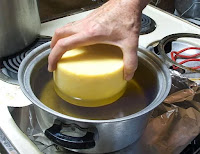Cheese, Nutritional Value of Cheese, Manufacturing Process of Cheddar Cheese Making 2020.
Cheese:
Cheese Meaning:
"Cheese is a dairy product produce by coagulation of milk protein casein. which is usually derived from cow milk, goat milk, buffalo milk & sheep milk and produce in a wide ranges of flavors, texture & form".
OR
"Cheese also defined as a product made from the curd obtained from milk by coagulation the milk protein casein with the help of rennet or other similar enzymes in the presence of lactic acid produced by added micro-organisms".
- Cheese is a one of the oldest foods of a mankind.
- Cheese was made accidentally in the stomach of animal carrying milk.
- When milk clotting enzymes of the stomach converted the milk into a solid mass.
Food & Nutritive Value:
Cheddar cheese has high nutritive value : 400 calories/100g
- Excellent source of milk proteins.
- Rich source of calcium & phosphorous.
- Source of vitamins (fat-soluble) A, D, E & K.
- Concentrated form of energy.
Manufacturing Process of Cheddar Cheese:
1.Cleaning of Equipment :
Cheese should be processed only in a thoroughly cleaned & sanitized equipment .Sanitary condition during cheese processing avoid contamination. All cheese making equipment & accessories should be sterilized just before use (hot water 82°C ) or (chlorine solution 100ppm for 2 min).
2. Receiving of milk :
The quality of finished cheese depends upon the initial quality of the milk. Only high quality of milk can yield high quality cheese. Milk should be free from any off-flavor. Milk should be free from all extraneous matter.
3.Pre-heating:
Milk is pre-heated at 35-40 ℃ for efficient filtration/clarification.
4.Standardization :
Adjust the casein/fat ratio in milk 0.68-0.70 to produce maximum amount of cheese per kg of fat in cheese milk.
5. Pasteurization :
HTST - 71 ℃ for 15 sec.
LTLT - 63 ℃ for 30 min.
To destroy pathogens, to destroy fault-producing micro-organisms.
6.Addition of calcium chloride :
Excessive heat-treatment slower renneting action & weaker curd so it can be corrected by the addition of 0.01-0.03% calcium chloride to milk.
7.Ripening :
Ripening is done by the addition of starter. Addition of starter is a heart of cheese. A good started is a most certain to give high-quality cheese & make up defects. Starter usually used in cheddar cheese is starter Lactis and starter Cremoris (0.5-1 % at 31℃ ). Stirred until smooth & creamy consistency.
8.Addition of color :
For 100kg of milk 30-200ml .The color is diluted with 20 times of its volume of water (annatto).
9.Renneting :
Rennet is available in liquid or powder or as tablet form. Rennet contains two principal enzyme rennin & pepsin. Rennin is an extremely powerful clotting enzyme which causes rapid clotting without much proteolysis. Pepsin induces proteolysis leading to bitterness in cheese. Rennet is commercially obtained from the true stomach of the young calf, known as the vell. The lining of the stomach is washed, dried, cut into small pieces and macerated into water containing about 4% boric acid at 30 ℃ for 5 day. Milk fed calves yield the purest rennet.
10.Coagulation :
In coagulation liquid milk changes to a semi-solid mass. Bubbles of air stirred into the milk surface take longer to break & spatula dipped into the milk & withdraw shows small flakes of curd.
11.Cutting :
The cutting of the coagulum into cubes of a specific size. The curd is first cut with the horizontal knife lengthwise, than with vertical knife lengthwise & widthwise.
12.Cooking :
After cutting the curd cube heating begin slowly. The rate of heating is such that the temperature rises to 32℃ -39℃ at the rate of 1℃ every 4 min.
13.Drainage of whey :
Removal of whey from the curd when the curd cubes have been reduced to about one-half of their size at cutting.
14.Cheddaring :
Cheddaring process is important for moisture controlling & improving body texture.
15.Milling:
Cutting the cheese blocks of cheddar curd into small pieces with the help of a cheese mill.
16. Salting :
Addition of common salt to the curd pieces. Salt in cheese affects flavor, body and texture & keeping quality
17.Hooping :
Curd being placed in hoops or moulds in which the cheese curd is pressed into its final shape.
18.Dressing :
Large cheese hoops are lined with cloth before they are filled with cheese curd for pressing. Small hoops are filled with curd and press for 30-60 min without any cloth. A cloth is necessary to form a close surface.
19.Pressing :
The operation of forcing the particles of milled and salted cured in the hoops into the smallest possible space.
20.Drying :
Removing of cheese from the hoops and stamping of cheese is done. Keeping cheese in a drying room at 12-16 ℃, RH 50%.
21.Paraffin :
The operation of dipping the cheese for a few second in a bath of melted paraffin.
Receiving of milk
︱
Pre-heating (35-40℃)
︱
Filtration/clarification
︱
Standardization
︱
Pasteurization(63 ℃ for 30 min)
︱
Addition of starter (Ripening )31℃
︱
Addition of color
︱
Addition of rennet (31℃)
︱
Coagulation
︱
Cutting
︱
Cooking (37-39℃)
︱
Drainage of whey
︱
Cheddaring
︱
Milling
︱
Salting
︱
Hooping
︱
Dressing
︱
Pressing
︱
Dry
︱
Paraffins
︱
Maturing













Comments
Post a Comment
If you have any doubt please let me know...